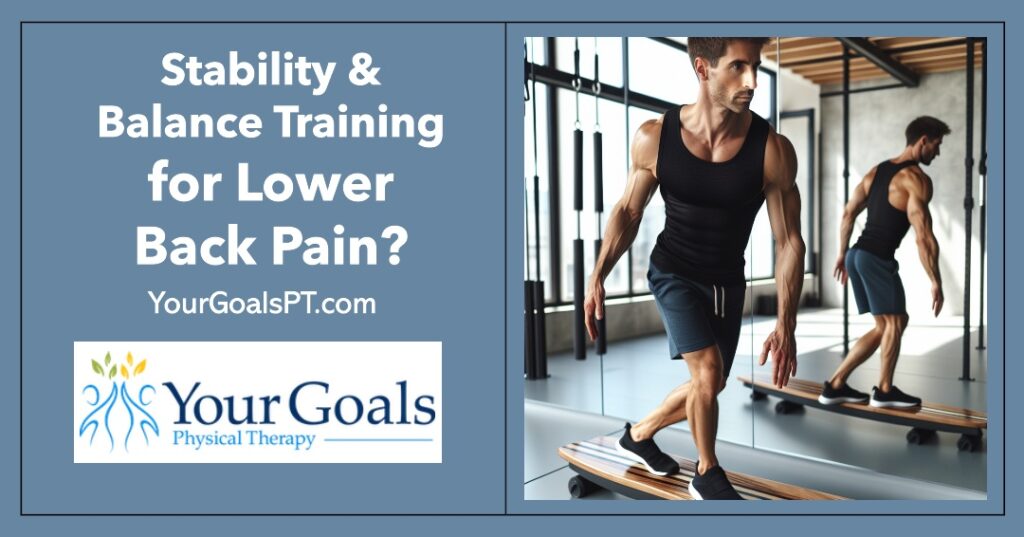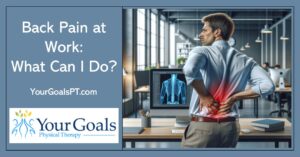The short answer to why stability and balance training are essential for lower back pain relief is because these training objectives train your body to control the amount of joint movement and compression at each level of your spine. By improving your stability and balance, you will reduce the overall force placed on your spine.
Let’s break down how each training objective works, how it improves running mechanics, and suggested exercise plans for each.
Stability Training
Stability training concentrates on improving your ability to keep your torso stiff while running. A stable torso is the ideal foundation your legs need in order to move smoothly and efficiently. This type of training is crucial for core stability and overall physical fitness.
How Stability Improves Your Running Mechanics
Many people forget how heavy their head and arms are since we carry them around all day. But think about this: While you run, you are constantly moving your body up and down. Over time, it can become tiresome to hold yourself in good upright posture, not to mention controlling your arm swing and trunk rotation.
To save energy, your body will let you slouch. Unfortunately, slouching your shoulders limits how deep you can breathe, and limits your natural arm swing and momentum. This can lead to stiffness and reduced range of motion.
In your lower body, with every stride you take, one leg is being pulled forward by your hip flexors and the other is being pulled back by your glutes. This alternative motion creates an opposing force on your pelvis, which when your trunk muscles get fatigued they stop resisting. Then your trunk will rotate, bend to either side, with every stride, eventually the excessive motion will wear down joints in your spine.
Just think about it, all that energy you’re using on trunk motion could be spent moving you forward at a faster pace or for a longer distance. By controlling that motion, you are reducing the stress on your spine and potentially preventing chronic pain or musculoskeletal disorders.
Stability training and strengthening core muscles are two most effective ways to optimize your stride—and protect your lower back.
The Lumbar Multifidus
The Lumbar Multifidus muscle, which is the largest deep muscle along the spine, is essential for counteracting lower back flexion caused by the abdominal muscles. You can stop damage to your lumbar spine by strengthening your multifidus muscles; since a strong multifidus prevents excessive flexion of the spine.
Where training lower back muscles goes wrong, causing injury, is with exercise that actively extends your spine into excessive lordosis, especially with resistance. The Lumbar Multifidus holds the vertebrae in place by resisting flexion, not extending into lordosis. This means the exercises that strengthen your multifidus are trunk stabilization exercises, not lumbar extension exercises.
Balance Training
Balance training concentrates on improving how steady you are on your feet, on uneven surfaces, and on one foot. This type of training is essential for fall prevention and improving overall physical strength.
How Balance Improves Your Running Mechanics
Running is essentially a single leg activity with momentum. It is not common for some to think about training their balance if they don’t fall or trip when they walk. However, with all sport activities, you should train your muscles in a way that mimics the movements you use during the sport. This improves your skills and prevents injuries. Therefore, for running, balance training has big payoffs.
When running, every stride you take has you landing, quietly preferably, on one foot then transitioning your weight from behind that foot (or on top of your foot depending on stride length/style) to in front of that stance foot, while bringing your other leg forward to do it all again.
There is a lot going on when you run. If your foot or ankle moves all over the place while you are simply standing in one place, then that is happening while you run. Not being able to control your ankles when you land means that your knee or hips will be affected.
How I Check Patients for Proper Form and Technique
When I first work with a runner for any reason, I check their single leg balance. More often than not I find they either have to shift their body weight dramatically over the standing leg bending their torso or their ankle moves so much that they can’t stand for 30 seconds.
With this one simple test I find out what happens every time they land while running.
It might not seem like a huge deal that you have to shift side to side; however, that is a lot of work for lower back muscles to continually pull you back to upright with every step you take. Not to mention, you have not been running when I do this test. What happens when you start to get fatigued?
Similar issue if your ankle moves a lot when you’re balancing on one leg. If when you land your ankle falls inward, towards your arch, your knees will rotate inward, which causes your hip to drop down. Over time, this running mechanics causes anything from patella femoral syndrome to lower back pain.
Examples of Stability Training Exercises
Examples of stability training exercises are:
- Plank variations
- Bird dog
- Dead bug
- Medicine ball rotations
These exercises focus on improving core stability and overall physical strength.
Examples of Balance Training Exercises
Examples of balance training exercises are:
- Single-leg stance
- BOSU ball exercises
- Heel-to-toe walk
- Yoga poses like tree pose
These exercises help improve balance, coordination, and can aid in fall prevention.
Although these exercises can be beneficial, it’s best to see a Physical Therapist who specializes in training runners to identify the exercises best for your situation.
I work with adult runners, 40 years old and up, to develop personalized programs for their specific needs. These programs often incorporate elements of strength training, stretching, and functional training to address issues like sciatica, spinal stenosis, and hip pain.
If you’re experiencing lower back pain or want to improve your stability and balance for better running performance, it’s critical to seek a professional who specializes in active adults. This can help prevent over-training and reduce the risk of strain injuries.
At Your Goals Physical Therapy, we help active adults end their aches and pains and reclaim their favorite physical activities – without medication, injections, or surgery.
If you are in the Cypress, Texas area, and you have a few questions about your specific situation, request to schedule a time to talk with me. On that call, we can discuss your specific situation, making sure we are a good fit before you commit to a paid service.
Ready to start? Complete the “ask about cost & availability” form and we’ll call you to create a personalized plan that addresses your specific needs, getting you back to running at the level you want.







